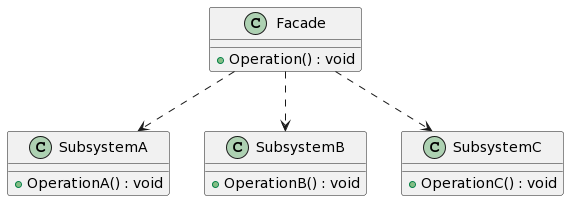1. What is the Facade Pattern
The Facade Pattern is a structural design pattern that provides a unified interface for accessing a set of interfaces in a subsystem. It hides the complexity of the subsystem and provides a simplified interface to the outside.
2. Characteristics and Advantages of the Facade Pattern
The Facade Pattern has the following characteristics and advantages:
- It provides a simplified interface, making the subsystem easier to use.
- It reduces the coupling between the client and the subsystem. The client only needs to interact with the facade class without needing to understand the specific implementation details of the subsystem.
- It conforms to the Open/Closed Principle and allows for convenient addition or modification of functionalities in the subsystem.
3. Examples of Practical Applications of the Facade Pattern
The Facade Pattern has a wide range of practical applications in development, such as:
- Providing a simplified interface to access complex third-party libraries or APIs.
- Encapsulating a set of complex logic operations to simplify the client's invocation process.
- Providing a simple interface for an existing system to integrate with other systems.
4. Implementation of the Facade Pattern in Golang
4.1. UML Class Diagram

4.2. Example Introduction
In this example, let's assume there is an e-commerce platform that includes order management, inventory management, and payment systems. The order management system is responsible for functions such as creating orders and querying orders, the inventory management system is responsible for querying product inventory and reducing inventory, and the payment system is responsible for processing order payments. To simplify the interaction between the client and the subsystems, we can use the Facade Pattern to design the interfaces of these subsystems.
4.3. Implementation Step 1: Define the Facade Class
type Facade struct {
subsystemA *SubsystemA
subsystemB *SubsystemB
subsystemC *SubsystemC
}
func NewFacade() *Facade {
return &Facade{
subsystemA: NewSubsystemA(),
subsystemB: NewSubsystemB(),
subsystemC: NewSubsystemC(),
}
}
func (f *Facade) Operation() {
f.subsystemA.OperationA()
f.subsystemB.OperationB()
f.subsystemC.OperationC()
}
4.4. Implementation Step 2: Define the Subsystem Classes
type SubsystemA struct {}
func NewSubsystemA() *SubsystemA {
return &SubsystemA{}
}
func (s *SubsystemA) OperationA() {
// Logic for Subsystem A operation
}
type SubsystemB struct {}
func NewSubsystemB() *SubsystemB {
return &SubsystemB{}
}
func (s *SubsystemB) OperationB() {
// Logic for Subsystem B operation
}
type SubsystemC struct {}
func NewSubsystemC() *SubsystemC {
return &SubsystemC{}
}
func (s *SubsystemC) OperationC() {
// Logic for Subsystem C operation
}
4.5. Implementation Step 3: Implement Client Code Using the Facade Pattern
func main() {
facade := NewFacade()
facade.Operation()
}